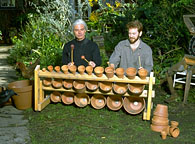(Click on any picture to see an enlargement.)
 |
 |
This instrument was created from commercial terra cotta flowerpots purchased at a garden supply store. The description that follows is excerpted from an article written for Experimental Musical Instruments, Volume IX #3, March 1994. The flowerpotophone is featured on the Ellipsis Arts CD release Gravikords, Whirlies, and Pyrophones.
Sound files (in RealAudio):
Hear an excerpt of "Terra Zona" performed on the potophone
Hear another excerpt of "Terra Zona" performed on the potophone
Some clay pots produce wonderful sounds when struck. Simple wind chimes or xylophones can be assembled by suspending pots from lengths of rope and striking them with mallets, bare hands, or other hanging pots. Clay pots that have been glazed or made watertight by other means can be filled with water to vary their pitches and produce other interesting effects. Stephen Micus has a fascinating recording on the ECM label in which he plays extensive sets of clay pots tuned with water.
I set out to create an instrument that could be made with inexpensive garden-variety terra cotta flowerpots. These pots will not hold water because the clay is porous and each pot has a hole in the bottom. Suspending the pots does not allow for a precise rhythmic playing style using mallets because the pots swing when struck. My goal was to create a method for mounting a collection of pots of various pitches in a stable manner so they could be struck repeatedly, with minimal damping of their sound. Another design goal was to provide easy striking access to all of the pots, for one or more performers, while achieving maximum directional projection to an audience (or microphone).
Selection of the pots was the first task. I started by auditioning all of the flower pots in my garage. Some of them sounded quite good, and I began to arrange them by pitch and search for more good-sounding pots. As my collection grew, I searched for pots with specific pitches that would fit in the intervals between the existing pots. At this point, I spent some time in local gardening stores, lurking in the flowerpot section with a rubber mallet and a pitch pipe. My goal was not to create a complete Western chromatic scale, but rather to create groups of pitches that complement each other. I ended up with several extended pentatonic scales plus miscellaneous intermediate pitches. The pentatonic scales have no relationship to each other, but are quite interesting when intermixed. These scales enhance the earthy, ethnic sound of the clay pots.
The pitch of a particular flowerpot appears to be based on a combination of the pot's diameter and the thickness of its clay walls. In general, pots with thin walls have a clear, well defined pitch due to their flexibility. Pots with very thick or rigid walls will produce only the "clink" of the clay body itself, not the "bong" of the resonating bell chamber. Flowerpots are available in a variety of shapes, which produce interesting timbral variations. Especially exciting are non-round (e.g., square or rectangular) pots, which have many non-harmonic overtones.
I mounted the pots on a three tier frame constructed of two-by-four studs. The method of mounting the pot is critical to the sound of the instrument, because anything that comes in contact with the pot will interfere with its vibration and dampen the sound. The pots are basically functioning as bells, so the least disruptive point of attachment is the vibrational node, which is at the center of the bottom of the pot (where the drainage hole is). Theoretically, minimum damping would be achieved by suspending each pot from a rope attached to its vibrational node. I opted to attach the pots to the beam by passing a bolt through a hole drilled through the wooden beam and then through the hole in the bottom of the pot, where it is secured with a washer and a wing nut (see diagram). Minimum contact with the wooden beam is achieved by resting each pot on three small rubber feet attached to the beam. (A good source for these rubber feet is Radio Shack.)
Different types of mallets can be used to produce a variety of sounds from the instrument. The most successful are rubber or yarn xylophone or marimba mallets. Superball mallets also work exceptionally well. (See Feb. 1990 EMI article on superball mallets.) The larger pots respond well to softer mallets, while the smaller pots require harder mallets in order to "speak".
Another fun design for this instrument would be to arrange the pots in such a way that two players could face each other with the instrument between them, providing both players striking access to all of the pots without interfering with each other.
Return to the Burnt Earth Gallery |